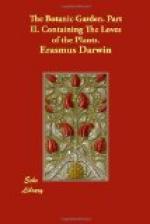3. There are numerous perpendicular fissures in the rocks of Derbyshire, in which the ores of lead and copper are found, and which pass to unknown depths; and might thence afford a passage to steam from great subterraneous fires.
4. If these waters were heated by the decomposition of pyrites, there would be some chalybeate taste or sulphureous smell in them. See note in part 1. on the existence of central fires.]
Impetuous
steams in spiral colums rise
Through
rifted rocks, impatient for the skies;
Or
o’er bright seas of bubbling lavas blow,
180 As heave and toss the billowy fires below;
Condensed
on high, in wandering rills they glide
From
Maffon’s dome, and burst his sparry side;
Round
his grey towers, and down his fringed walls,
From
cliff to cliff, the liquid treasure falls;
185 In beds of stalactite, bright ores among,
O’er
corals, shells, and crystals, winds along;
Crusts
the green mosses, and the tangled wood,
And
sparkling plunges to its parent flood.
—O’er
the warm wave a smiling youth presides,
190 Attunes its murmurs, its meanders guides,
(The
blooming FUCUS), in her sparry coves
To
amorous Echo sings his secret loves,
Bathes
his fair forehead in the misty stream,
And
with sweet breath perfumes the rising steam.
195 —So, erst, an Angel o’er Bethesda’s
springs,
Each
morn descending, shook his dewy wings;
And
as his bright translucent form He laves,
Salubrious
powers enrich the troubled waves.
[Fucus.l. 191. Clandestine marriage. A species of Fucus, or of Conserva, soon appears in all basons which contain water. Dr. Priestley found that great quantities of pure dephlogisticated air were given up in water at the points of this vegetable, particularly in the sunshine, and that hence it contributed to preserve the water in reservoirs from becoming putrid. The minute divisions of the leaves of subaquatic plants, as mentioned in the note on Trapa, and of the gills of fish, seem to serve another purpose besides that of increasing their surface, which has not, I believe, been attended to, and that is to facilitate the separation of the air, which is mechanically mixed or chemically dissolved in water by their points or edges; this appears on immersing a dry hairy leaf in water fresh from a pump; innumerable globules like quicksilver appear on almost every point; for the extremities of these points attract the particles of water less forcibly than those particles attract each other; hence the contained air, whose elasticity was but just balanced by the attractive power of the surrounding particles of water to each other, finds at the point of each fibre a place where the resistance to its expansion is less; and in consequence it there expands, and becomes a bubble of air. It is easy to foresee




